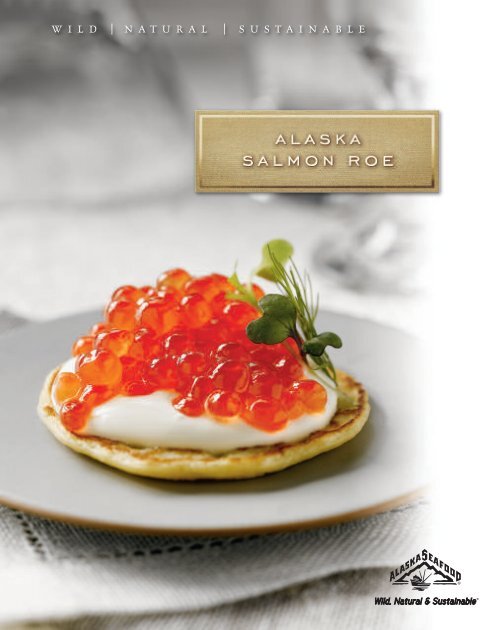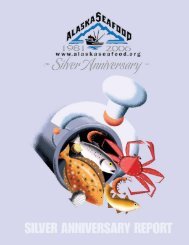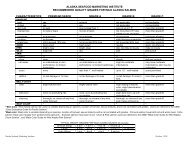w salmon caviar - Alaska Seafood Marketing Institute
w salmon caviar - Alaska Seafood Marketing Institute
w salmon caviar - Alaska Seafood Marketing Institute
Create successful ePaper yourself
Turn your PDF publications into a flip-book with our unique Google optimized e-Paper software.
W I L D | N A T U R A L | S U S T A I N A B L E
The cold, clean waters of <strong>Alaska</strong> provide a healthy, naturalhabitat for the five species of wild <strong>Alaska</strong> <strong>salmon</strong>. Each year, thisrich environment yields millions of high quality fish, famousfor their delicious flavor and superior texture. These same wild<strong>salmon</strong> produce some of the world’s finest roe, bursting with allthat is best about <strong>Alaska</strong> <strong>salmon</strong>.<strong>Alaska</strong> <strong>salmon</strong> roe is a wild, natural product high in leanprotein and omega-3 fatty acids. Often referred to as “Golden”or “Ruby” eggs, <strong>Alaska</strong> <strong>salmon</strong> roe products are indeed preciousand are chiefly enjoyed in the form of two elegant and flavorfuldelicacies: <strong>caviar</strong> and sujiko.Wild <strong>Alaska</strong> <strong>salmon</strong> roe is a resource strictly managed forsustainability. Constitutionally mandated regulations and closemonitoring of <strong>Alaska</strong>’s <strong>salmon</strong> fisheries help to preserve andprotect <strong>Alaska</strong> <strong>salmon</strong> roe for generations to come.
Purchasing/ReceivingAs a rule, high-grade <strong>salmon</strong> <strong>caviar</strong> has a consistentbright, red-orange outer color with a center thecolor and consistency of honey. Eggs should beshiny and slightly transparent, whole (not broken orsquashed) and easily separated from one another.In general, <strong>caviar</strong> is graded on the basis of egg size(larger is better), salt content (lower is better) anddrip (zero is best). High-grade <strong>caviar</strong> eggs shouldbe firm but pliable to pressure without breakage.<strong>Alaska</strong> <strong>salmon</strong> <strong>caviar</strong> should have a mild, pleasantsmell and a rich taste.To provide additional product safety andincrease shelf life, some <strong>salmon</strong> <strong>caviar</strong> is soldpasteurized. Product taste is not significantlyaffected by pasteurization. Pasteurized productmay be softer, lighter in color, and less shiny inappearance than non-pasteurized product. Morejuice is also accepted in non-pasteurized product.In general, higher-grade <strong>caviar</strong> can withstand thepasteurization process best.Some <strong>Alaska</strong> producers pack <strong>caviar</strong> in modifiedatmosphere packaging (MAP) trays. These aresealed trays that are either flushed with nitrogengas to remove the oxygen, or contain packets ofoxygen-consuming granules. By minimizing theoxidation of oils in the eggs, the frozen shelf lifecan be increased.KETA SALMON, Oncorhynchus keta<strong>Alaska</strong> keta <strong>salmon</strong> are harvested in late summer. Keta<strong>salmon</strong> roe is pale red with strong orange overtones.Keta <strong>caviar</strong> is the most popular type of <strong>salmon</strong> <strong>caviar</strong>,prized for its large size. The highest-grade keta <strong>caviar</strong> is5 mm or larger with a salt content of 2.5 to 3.5 percentand zero drip.* Keta <strong>caviar</strong> is also regarded for its flavor,long shelf life and signature “pop” in the mouth.PINK SALMON, Oncorhynchus gorbuscha<strong>Alaska</strong> pink <strong>salmon</strong>, the smallest and most abundantof the <strong>Alaska</strong> <strong>salmon</strong> species, are harvested in latesummer. Pink <strong>salmon</strong> roe is orange with a subtle rosehue. The highest-grade pink <strong>caviar</strong> is 3.5 mm or largerin size, with a salt content of 2.5 to 3.5 percent andzero drip.* Pink <strong>caviar</strong> is valued for its sweet, mildtaste and long shelf life.*Salmon roe of smaller size or higher salt content is graded according to individual company specifications. Producers have their own specifications,so it is important for buyers to work closely with their suppliers.Note: Caviar salt content is market determined and is not subject to food safety regulations.
StorageSalmon <strong>caviar</strong> can be frozen to increase shelf life.As with pasteurization, higher quality product isbetter suited for freezing. While other types of<strong>caviar</strong>, such as sturgeon, are not suited for freezing,<strong>salmon</strong> eggs have thick membranes that preventdamage. The salt content in <strong>salmon</strong> <strong>caviar</strong> causesfreezing to take place at low temperatures.For long-term storage, -40° C is recommended.Thawing should take place slowly in order topreserve quality. Caviar in wholesale packages isnormally kept frozen below -10° C.Steve LeeSOCKEYE SALMON, Oncorhynchus nerkaMost <strong>Alaska</strong> sockeye <strong>salmon</strong> are caught in mid-summer.Sockeye <strong>salmon</strong> roe is bright red and significantlysmaller than that of the other <strong>salmon</strong> species. Muchof the sockeye roe harvest is sold in-sac (as sujiko),though some is used for <strong>caviar</strong>. The highest-gradesockeye <strong>caviar</strong> is 2.5 mm and up and has a saltcontent of 2.5 to 3.5 percent and no drip.* Sockeye<strong>caviar</strong> can have a slightly bitter natural finish andhas a shorter shelf life than other species due to thenatural fats found in the yolk of the eggs.COHO SALMON, Oncorhynchus kisutch<strong>Alaska</strong> coho <strong>salmon</strong> run later than the other speciesand are generally the last to spawn. Coho <strong>salmon</strong> roeis mid-sized and closer to red than orange in color.The highest-grade coho <strong>caviar</strong> is 4.5 mm and up, witha salt content of 2.5 to 3.5 percent and no drip.* Likesockeye, coho <strong>caviar</strong> has a slightly bitter natural finishand shorter shelf life caused by unstable fatty acids.
Al a sk a Salmon RoeNutrients and Fatty Acids *NUTRIENTAMOUNT PER1 OZ. SERVINGNutritional InformationWhile <strong>Alaska</strong> <strong>salmon</strong> is known for its highlevel of heart healthy omega-3 fatty acids andlean protein, the omega-3 and protein contentfound in the roe far exceeds that of themeat. In addition, important vitamins andminerals are abundant in <strong>Alaska</strong> <strong>salmon</strong> roe.CaloriesCalories from fat60 cal15 calTotal fat2 gSaturated -Monounsaturated -Polyunsaturated -ProteinSodium9 g390 mgCalciumIronVitamin A (retinol)Vitamin CCholesterol0 mg0 mg10% of DV5% of DV145 mgn-3 Fatty acidsAlpha-linolenic (ALA) -Eicosapentaenoic (EPA) 310 mgDocosapentaenoic (DPA) -Docosahexaenoic (DHA) 370 mgTotal EPA + DHA680 mgKING SALMON, Oncorhynchus tshawytscha<strong>Alaska</strong> king <strong>salmon</strong> arrive earliest in the summer<strong>salmon</strong> season and are harvested year-round in <strong>Alaska</strong>.It is important to note, however, that king <strong>salmon</strong>roe is only taken in the summer months. Like keta,king <strong>salmon</strong> produce large eggs. The highest-gradeking <strong>caviar</strong> measures 5 mm and up, has a salt contentof 2.5 to 3.5 percent and no drip.* King <strong>caviar</strong> is richin flavor and produces a pleasant “pop” in the mouth.*Mean values in 3 samples of pink <strong>salmon</strong> <strong>caviar</strong>Analyzed by Medallion Labs, 2004Courtesy of <strong>Seafood</strong> Products Association, Seattle, WANote: Data based on <strong>Alaska</strong> pink<strong>salmon</strong> roe, which is representativeof most kinds of <strong>Alaska</strong> <strong>salmon</strong> roe.However, actual amounts will varybetween species and according toindividual packers.
S U J I K OTraditional Japanese sujiko features salted and cured <strong>Alaska</strong> <strong>salmon</strong> roe withinthe natural membrane or film (in-sac). Sujiko is a Japanese word composedof “suji,” which means “line,” and “ko,” which means “child.” The name refers tothe way in which the eggs are lined up in the ovary. The raw egg sacs are washedin a saturated brine solution, drained, packed with salt and then allowed to cure.Grading InformationTypically, there are three standard grades of sujiko: No.1, No.2 and No.3, plus“off-grade” which includes roe that is cut, broken, soft, or off-color. In general,high-grade sujiko usually follow these guidelines:• Eggs are large in size for the species• Color is bright and uniform throughoutthe sac• Eggs are firm and fresh at a balancedmaturity level, neither too oldnor immature• Surface membranes are strong yetsoft with the sac intact and with eggsarranged in neat linesLower grades of sujiko are well suitedfor the production of <strong>salmon</strong> roe spreads,pâtés and butters.<strong>Alaska</strong> <strong>salmon</strong> sujiko can be purchased as salted sujiko, soy-marinated sujiko,or as frozen unprocessed roe. Packaging typically includes origin, importer contactinformation, and will state whether or not the product is lower in salt content oruses a salt substitute.Producers have their own specifications, so it is important for buyers to workclosely with their suppliers.
Steve LeeAll <strong>Alaska</strong> seafood is wild and sustainable and is managedfor protection against overfishing, habitat damage and pollution.In <strong>Alaska</strong>, the fish come first!Unlike fish stocks in other parts of the world, no <strong>Alaska</strong><strong>salmon</strong> stocks are threatened or endangered. For this reason,<strong>Alaska</strong> <strong>salmon</strong> roe represents a responsible, natural choice intoday’s global seafood market.For more information on <strong>Alaska</strong> <strong>salmon</strong>, how they areharvested and the great variety of products that are availablefrom this fishery, please refer to the <strong>Alaska</strong> Salmon Buyer’sGuide from the <strong>Alaska</strong> <strong>Seafood</strong> <strong>Marketing</strong> <strong>Institute</strong>.ALASKA SEAFOOD MARKETING INSTITUTE • www.alaskaseafood.org • 800-478-2903International <strong>Marketing</strong> Office & Administration: 311 N. Franklin St., Suite 200, Juneau, AK 99801U.S. <strong>Marketing</strong> Office: 150 Nickerson Street, Suite 310, Seattle, WA 98109 • 800-806-2497© 2010 ASMI 21-052








